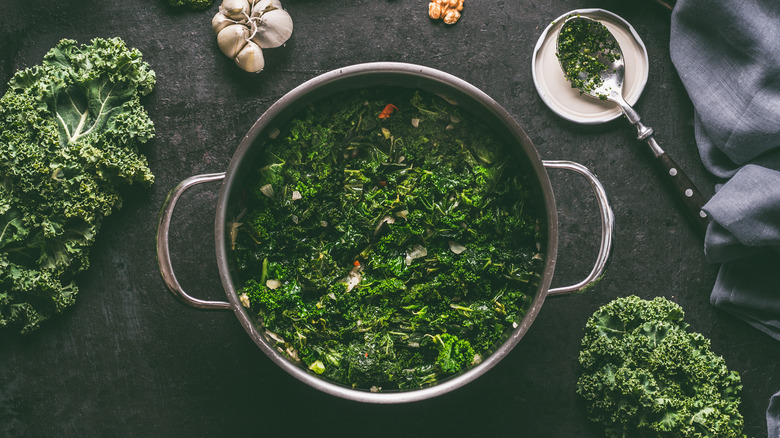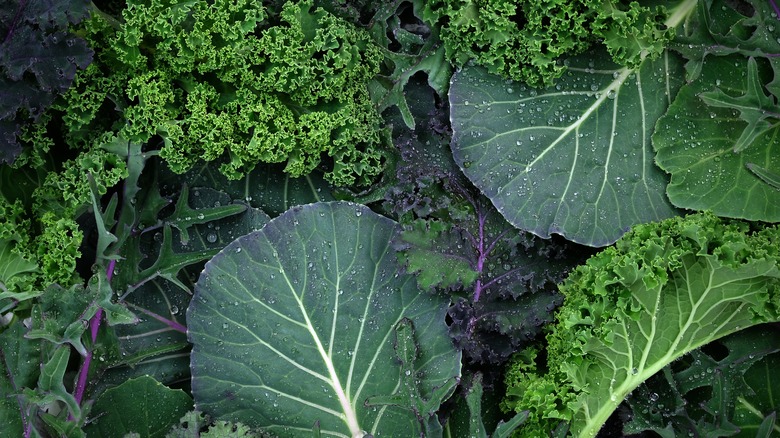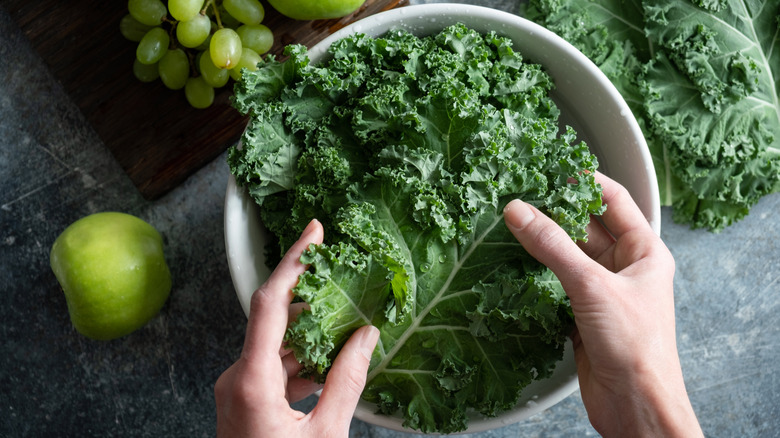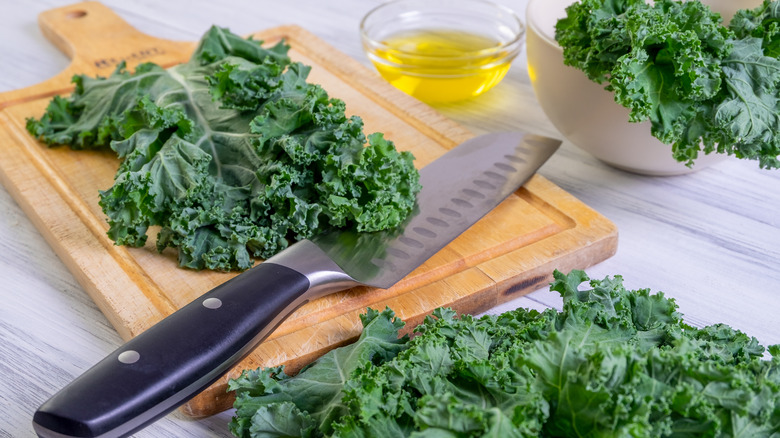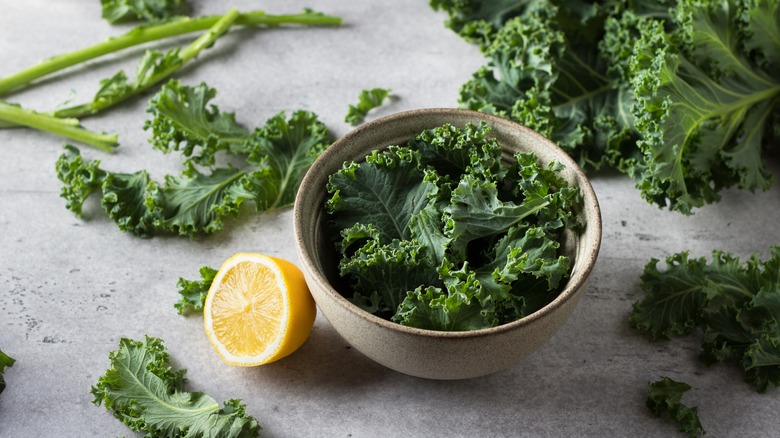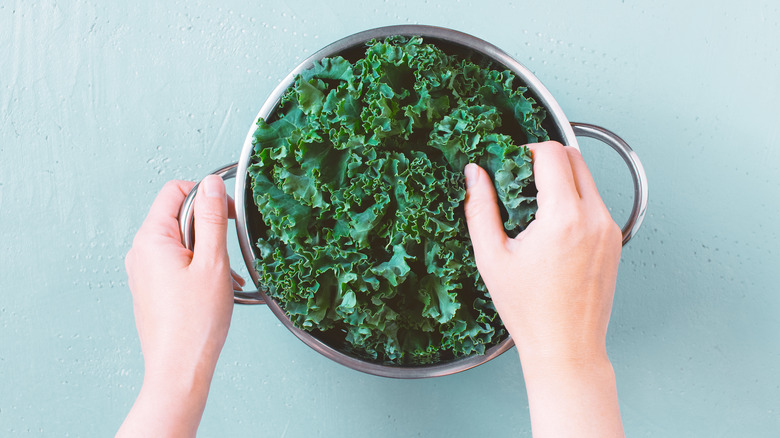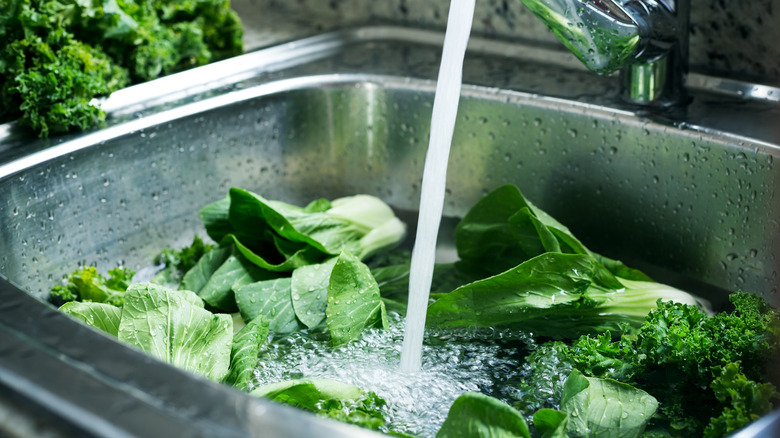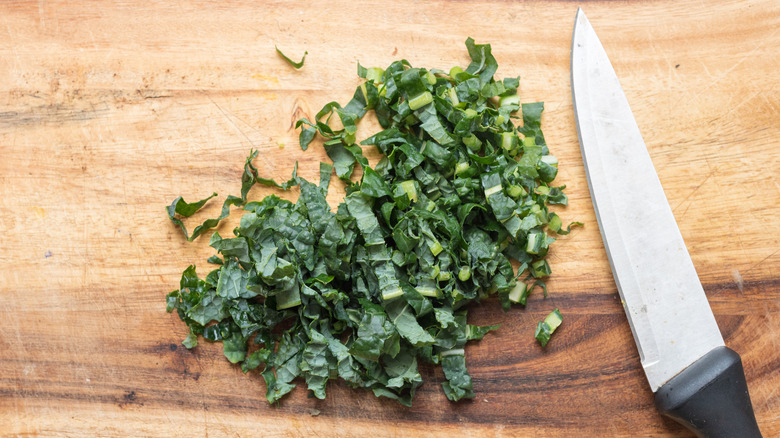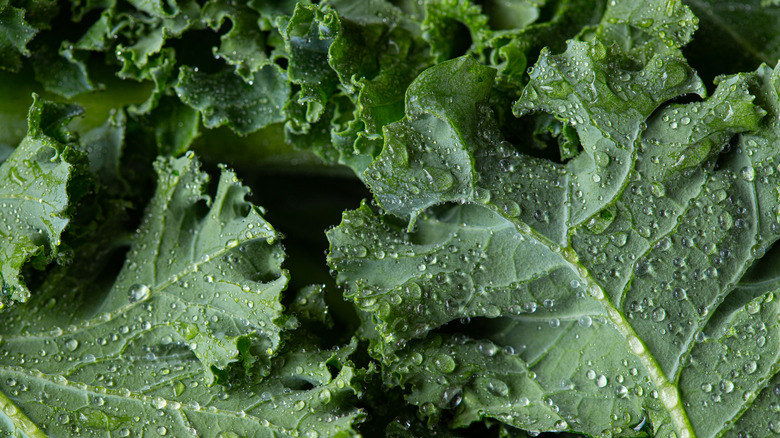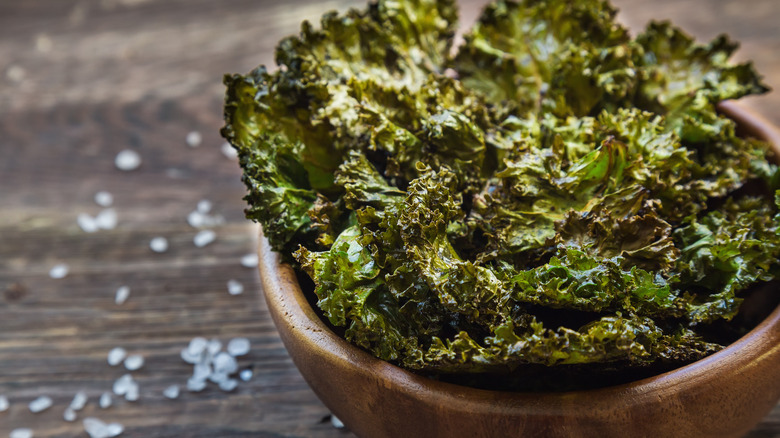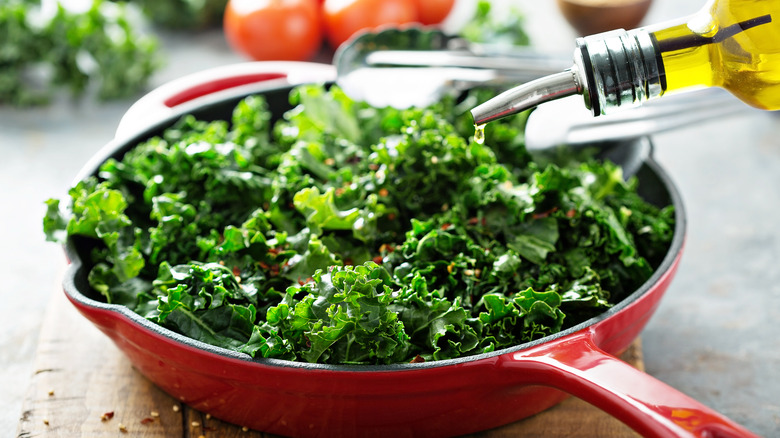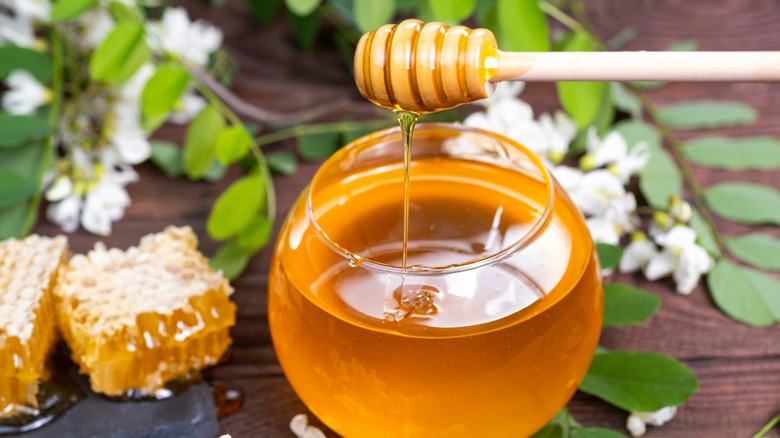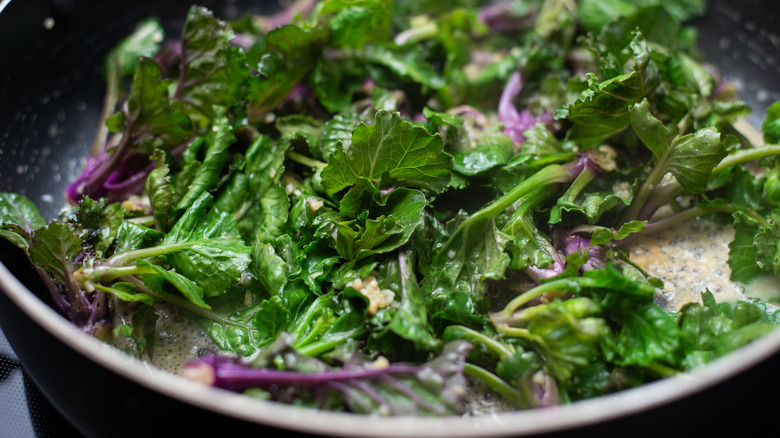12 Tips You Need When Cooking With Kale
Kale is one of those buzzy culinary words that pop up as an ingredient in multiple recipes that claim to be healthy. After all, it is a leafy vegetable with applications similar to spinach or arugula. But unlike the more tender-leafed greens, kale is hearty, chewy, and bitter. Fibrous and tough, it's easy to get turned off to this ingredient if you just try to eat it in its natural state without preparation.
Here's the thing, though, kale is super good for you. WebMD states it is a powerhouse of vitamins C, A, K, and folate. Calcium, potassium, and phosphate are also abundant in the leafy green. With so many nutritional benefits, it's worth learning to cook with kale to take advantage of everything it offers.
Don't be intimidated; preparing it is actually fairly easy. You might find yourself including it more often in your daily recipes after you've built up your culinary kale confidence.
Choose the right type of kale for your dish
Not all kale is created equal; many varieties are available, so when you're shopping, make sure that you're selecting the correct type of leafy green for the dish you're making.
As implied by its name, baby kale is a very young vegetable, which means it's more tender and less bitter than the more mature option. Because it's more approachable, it is one of the best choices for raw salads. It's bursting with nutritional value without being too chewy or tough. Italian, or dinosaur kale, has wrinkled, fibrous leaves that become more tender when they're sautéed, making them a great addition to stir-fries or sauces. Its flavor is more intense and peppery, and cooking them down actually curbs some of the bitterness that might normally be considered overwhelming if eaten raw.
So, double-check your recipes when making your shopping list, and be aware of what sort of kale you'll need. It will set you up for a more delicious dish.
Remove the fibrous stem
One of the characteristics of kale that sets it apart from other greens is its thick stem that runs through the center of the leaf. It can be very tough and more bitter than the other parts. If you want to reap the benefits of the vegetable and keep the leaves as tender as possible, you will want to remove the stem. This might be an additional step you're not used to doing with other greens, but it's worth it.
You don't have to trash the stems, either; there are actually uses for these leftovers once they've been stripped out of the kale. Typically, you'll want to dice them up to make them more manageable. They can go into soups, stir-fry, and even smoothies. Texture-wise, you'll want to treat these fibrous pieces like celery, another toothsome vegetable that can be somewhat divisive. The kale stems can be eaten raw as long as you slice them finely or cut them up small enough. They can also be made into pesto, added to artichoke dip, or even air-fried to make crunchy chips.
Cut the leaves into uniform pieces
One of the most important proper cooking techniques that come up repeatedly is to keep the sizes of your ingredients consistent. When all your cuts are the same size, it promotes more even cooking, meaning you'll end up with fewer burned or undercooked pieces and have, overall, a more enjoyable eating experience.
Kale is no exception. Because the vegetable is denser and hardier than most other leafy greens, it requires a bit more cooking than baby spinach, which can be reduced very quickly. You need to ensure that when cutting the leaves to go into your sauté pan, they're all approximately the same size so that you don't end up with a tough, undercooked piece in the same mouthful as a mushy, overcooked one. Chopping the kale smaller will also help the veggie cook faster, allowing you to treat it more like your typical greens.
Use citrus to soften the leaves
Citrus is a natural tenderizer; you often find lemon, orange, or grapefruit juice as the main component in marinades for many meat dishes. This is because enzymes found in these fruit break down proteins and make tougher cuts more tender. This same simple trick of science works with the tough leaves of kale, as well.
The vegetable has a high ratio of cellulose compared to other leafy greens. Cellulose is the natural fiber found in veggies, and it's basically indigestible. According to the Mayo Clinic, high-fiber diets are beneficial for your overall health, as the insoluble fiber found in greens like kale keeps your gut health in balance. But this can also make the vegetable tough to eat uncooked. So, if you plan to include raw kale in your meal, give it a chop, then squeeze some lemon over the top and allow it to sit. The natural acids and enzymes in the citrus juice will soften the cellulose and add a bright flavor to the leaves.
Massage your kale
When it comes to tenderizing this leafy green, adding acid and chopping the vegetable makes perfect sense. But one practice that many chefs recommend is slightly less intuitive: To break down the tough fibers, it's actually suggested that you massage your kale.
You don't need to light candles and put on your Enya mix, but giving this veggie a rub down makes it much more tender. Once you've removed the tough center stem and cut the greens into fork-sized pieces, you can drizzle the kale with some olive oil, sprinkle with salt, then start rubbing the leaves together. Massaging helps break down the cellulose before it hits your salad plate. Once you've given the kale a good squeeze, you can squeeze a lemon over the bowl and let it sit while you prep the rest of your dinner.
Don't be shy about tasting it during the massage; that way, you can test if it's tender enough. If it's still too chewy, keep working at it. While this might seem like an odd extra step, when you think about how many health benefits kale imparts, a little rub down is a small price to pay.
Wash kale thoroughly before use
Washing produce is incredibly important. According to the FDA, there are many points between harvest and food preparation where vegetables can come into contact with contaminants. From pesticides and human and animal waste to bacteria in the soil, many icky things can be clinging to veggies when you bring them home from the supermarket. So you'll want to make sure that you wash your kale thoroughly.
With its broad leaves and frilly or wrinkled texture, the leafy green can hold onto grit better than other vegetables. There are two methods for getting kale nice and clean: You can put the leaves into a colander and run cold water over them while rubbing them to free them of trapped dirt (as a bonus, this gives you a head start on your tenderizing process). The other way is to fill your sink with cold water and put all the pieces into the sink, swishing them around in the water to allow the particles to drift to the bottom.
Once your kale is nice and clean, thoroughly dry it. Don't wash the leafy green too far ahead of time, though. If you want to keep the veggie fresh, let it remain dirty and dry until you're ready to use it.
Chiffonade raw kale for salads
When it comes to salads, it's easy to throw everything together into a bowl without too much consideration. You probably know by now, though, that kale needs a little extra TLC before it can join the rest of your greens. Once it's been thoroughly washed and massaged, you can chiffonade it. Also called the ribbon cut, this is a very unique and fun method of cutting leafy vegetables and herbs. It creates gorgeous tendrils which can add different textures to your salad and make raw kale much easier to chew since it's been sliced so thin. While it looks fancy, the chiffonade cut is actually incredibly easy.
Once the leaves have been washed and thoroughly dried, you'll want to stack them evenly on top of one another. After you've put three or four leaves together, roll them up tightly like a cigar. Using a sharp knife, slice down the length of the roll to create feathery strands. Once you have enough of the fluffy ribbons, toss them in dressing and add them to your salad to make it look even more elegant, or include a healthy dose of the nutrients!
Soak your kale leaves in ice water
Kale is part of the Brassica family, encompassing mustard plants, cabbages, brussels sprouts, and broccoli. One thing that all these vegetables have in common is a certain level of bitterness. The source of that bad taste is glucosinolate, a sulfur-containing substance that gives off that very familiar rotten egg smell while cooking. However, according to Verywell Fit, it might actually be highly beneficial. When your body breaks down the compound, it becomes multiple metabolites, which have been shown to protect cells from damage.
In other words, what makes kale bitter also makes it good for you. Still, that doesn't make it any more palatable. To reduce this strong taste in your greens, all you need to do is soak your kale in an ice bath. On top of reducing the bitterness, the ice bath can also revive the leaves if they've become a little limp in the fridge.
To take full advantage of these benefits, you'll want to wash and chop your leaves first. Chopping the greens before they hit the ice water releases some sulfuric compounds, which the bath will clean away, leaving you with much less-bitter kale for your cooking or salads.
Cook kale chips low and slow
Kale started rising in popularity once people discovered you could make chips out of it. A crunchy, salty snack that is actually good for you? It seems too good to be true, but you'd be surprised. Part of the appeal is that they can be customized; make them either cheesy or tangy with a salt and vinegar twist. You could even dust them with taco or Cajun seasoning to give them a spicy zing.
The trick to getting crunchy kale chips seems pretty intuitive. You want to ensure the leaves are nice and dry before you toss them in oil and get them in the oven. Moisture is the enemy of crispiness, so after you thoroughly wash your chopped veggie, make sure it takes a ride in the salad spinner or use paper towels to completely dry the ingredient. This allows the oil to cling to the leaves and reduces the steam created in the oven, leading to crunchier chips.
You also want to bake those chips low and slow, letting the greens crisp up with time. This will lead to more even cooking. Keep your eye on the oven, ensuring the chips don't burn. Once you pull the kale out, let the pieces rest to attain their final crunchy form before diving in and enjoying your snack.
Wilt kale before adding it to salads
If you want to add kale to your salad, but don't want to fight through the bitterness and the toughness, adding some heat and oil might be the remedy you need. Breaking down cruciferous veggies with vinegar and oil is also called "killing" them. Usually, this involves sautéing the vegetables in a pan with aromatics like onion and garlic and adding vinegar, bacon, and oil so the leaves can soften and become much more palatable. This works especially well if you're using one of the tougher varieties of kale that would otherwise just be too toothsome for a raw salad.
You can also use this process for cooking out most of the bitter notes that might otherwise overshadow the taste of your salad. The warmed kale will taste much milder, and the saltiness of the bacon will complement it. However, wilting the leafy green before adding it to your dish doesn't just change the vegetable's flavor; it also adds a different texture component.
Add a touch of sweetener
While sautéing your kale will reduce the bitter flavor, you can also help take the edge off your greens by adding a bit of sweetener. Honey, maple syrup, agave, and even a pinch of brown sugar are all excellent ingredients to add sweetness to your dish.
Honey and maple syrup are easy additions that will caramelize around your leafy greens as they wilt in the pan. Balsamic vinegar is also a fantastic, if not surprising, way to add some sugar to your kale dish; unlike other varieties, which are made from aged wines and are very acidic, it is made directly from the grape, including the skin, flesh, and seeds. It produces a unique sweetness when it is aged and then cooked down. The tangy zing and fruity body of the balsamic will elevate your vegetable by adding additional dimension.
When adding sweeteners to your dish, be sure to taste test. The flavor of the kale will continue to get milder the longer it cooks, so if you're just trying to offset the bitterness, a little sugar will go a long way.
Add water to the sauté pan
It can't be overstated that kale is a tough vegetable. It's sort of what it's known for and why most people tend to avoid cooking with it. However, the good news is that you can sauté the leaves as you do with spinach and make truly delicious wilted greens.
If you want to make sure your kale ends up nice and soft, you'll want to add a few tablespoons of water into your sauté pan and put a lid over it. This will steam the veggie and pre-soften it a bit before you add a little oil and start to cook it in earnest. If you want to add flavor, use chicken or vegetable stock instead of water to steam the kale. You'll be impressed by how just including some liquid helps break down and tenderize the greens — so much so you might find yourself bringing the veggie into your standard ingredient rotation!
